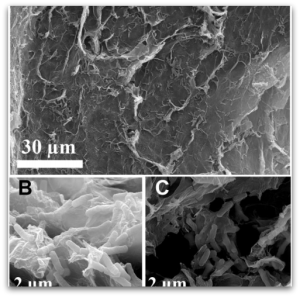
The new anode can transfer electrolytes from bacteria in wastewater to a microbial fuel cell.
Image: Science Advances
With 783 million people world-wide lacking access to clean drinking water and more than 35 percent of the world’s population without access to improved sanitation facilities, researchers are pursuing new ways to clean wastewater that is both effective and energy efficient.
An interdisciplinary team from multiple institutions in China has developed a new freestanding anode that can take harmful electrolytes form bacteria in wastewater and transfer them to a microbial fuel cell. This new process opens the door to effectively cleaning wastewater while converting waste to electricity.
The treatment of wastewater is an essential, yet energy intensive, process. While scientists have been exploring new ways to treat wastewater, none of the option has been very energy efficient.
Many current wastewater treatment plants function through fermentation and the burning of methane. The research team from China opts for an alternative method, where they create sewage-based fuel cells that pull the bacterial electrolytes and create electricity.
This from Phys.org:
The new anode is based on a 3D graphene aerogel decorated with platinum nanoparticles—the team describes it as a “macroporous structure that is favorable for microorganism immobilization and efficient electrolyte transport.” In the lab it looks somewhat like a lump of pumice, the porous surface offers more surface area. The team tested the probe first with water infested with Shewanella oneidensis bacteria, noting how the bacteria became lodged in the pores of the anode. They further tested it with a microbial fuel cell and wastewater samples taken from an actual wastewater treatment facility, and proved the probe worked as designed by using the resultant energy claimed from the sewage to power a small digital kitchen timer.
While the process in not efficient enough for mainstream use, there is much potential for future application. The development of this freestanding anode has the potential to open the door to a new way of efficiently treating wastewater.
PS: Check out updates of ECS’s Science for Solving Society’s Problems Challenge to see what our scientists are doing to battle issues in water and sanitation.

